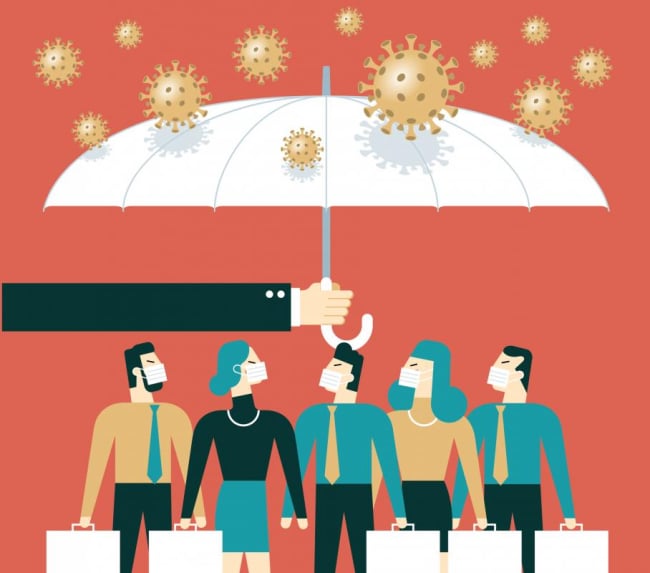You have /5 articles left.
Sign up for a free account or log in.

sorbetto/digitalvision vectors/getty images
As we’re all well aware, the global public health crisis caused by the COVID-19 pandemic has presented unprecedented challenges for higher education, among them the need for leadership to quickly respond to the unforeseen multidimensional consequences of the pandemic. In fact, the extent to which colleges and universities manage to protect their constituents, support the community and move forward during and after times of crisis like the pandemic strongly depends on their leaders.
When the pandemic began, we were a team of seven current and emerging leaders from across the State University of New York system who participated in the SUNY Hispanic Leadership Institute program. Due to COVID, the remainder of the program’s activities went virtual and continued without jeopardizing its goals. That provided us with an unusual opportunity to reflect on the crisis as leaders and to share our experiences as challenges emerged.
Although extensive literature on leadership skills and practices already exists, here we reflect on and define the main roles of higher education leaders in the time of crisis through the lens of the ongoing global events. Based on our experiences and the current circumstances, we’ve identified five main roles -- interdependent, equally important and nonhierarchical -- that higher education leaders should include in their tool kits to help them manage and overcome crises.
Model. Crisis situations are filled with ambiguity and uncertainty, but they provide opportunities for higher education leaders to reflect and better understand themselves and their skills, teams, students and institutions. Given the complex nature of higher education institutions, a leader must inspire trust, safety, transparency, presence and inclusivity to set the appropriate tone with behaviors that their constituents can look up to and want to emulate. College and university leaders that are models communicate clearly and continuously to ensure the safety of everyone on campus and to set clear expectations, balancing reality with hope and empathy. They establish and communicate goals openly and seek out commitment from the community. By being up front and open about the uncertainty of the situation, and sharing their concerns and fears, college presidents and other leaders on a campus can earn trust from their community and inspire others to move forward together.
When you are a model leader, every message you send is crucial. For example, amid the pandemic, Havidán Rodríguez, president at the University at Albany, frequently communicated through press releases, video conferences, announcements, emails and social media to minimize stress among all members of the campus community. In every public engagement where he addressed issues involving the crisis, he encouraged an open dialogue that allowed people to raise concerns and then followed up with detailed plans for tackling those issues.
As he has led his team through those trying times, he has also launched and supported a variety of initiatives aimed at ensuring safety at the university, including UAlbany Forward Together, which focused on the continuity and well-being of the community for fall 2020 and beyond. Other leaders of his institution and the SUNY system, as well as throughout New York State and nationally, have commended his transparent approach.
Supporter. During the pandemic, higher education leaders have recognized the need to be responsive to all members of their communities as they work to solve urgent problems and make quick strategic decisions. From presidents to faculty to staff and student leaders, we have all been confronted with unprecedented situations in which we cannot make such decisions or find coherent solutions for maintaining the continuity of academic programs without the help and support of others at our institutions. In the supporter role, a leader listens to the needs of the community, facilitates relationships, shows empathy and provides the necessary tools to act fast and strategically in a manner consistent with institutional values and culture.
As supportive higher education leaders, we cannot ignore the social impact caused by the disruption of campus life and the burden associated with social distancing and other isolation measures taken to stop the spread of the coronavirus. To address that, academic support leaders from SUNY Empire State College, with the help of newly named SUNY chancellor Jim Malatras, developed a live virtual engagement program covering a broad range of topics to connect with students, faculty and staff throughout each day.
Visionary. In a crisis, a leader needs to embrace the opportunity to think and act big -- as well as responsibly and fast. The economic impact of the pandemic on higher education and how long it will last is still unfolding. But its effects on enrollment, student mobility and funding for public higher education undoubtedly are, and will continue to be, significant. As visionaries, higher education leaders must be willing to take risks and look for innovative ways for the institution and its community to become more resilient.
The coronavirus outbreak created the perfect combination of adverse factors for higher education academic programs and institutions facing the possibility of losing enrollment and program accreditation. To overcome those challenges, visionary academic leaders have had no choice but to make the decision and establish direction to rapidly move all in-person teaching to distance learning. As we all know, that move came with its own set of challenges, including the immediate need to train faculty who had never taught remotely before. In response, SUNY Online, SUNY Center for Professional Development and faculty and instructional support leaders from across the SUNY system facilitated a series of remote teaching clinics to support faculty during the disruption.
While continuity has been a challenge for all academic programs across the nation, institutions with clinical components, such as nursing and dentistry, faced a more acute situation because they serve both the students and the community. The University at Buffalo School of Dental Medicine had to develop robust alternative simulations in which students were able to evaluate dental procedures in a realistic manner to ensure fulfillment of the clinical standards required for accreditation. In a short period of time, these visionary leaders were able to design a similar experience for students virtually without actual patients -- something the dental program had never done before.
Although we cannot foresee when the next crisis event will happen, a visionary leader needs to plan for the unthinkable during and after a crisis. The former president of Tulane University, Scott Cowen, shared some valuable lessons learned through the recovery from Hurricane Katrina that could be useful to other college presidents while navigating the current COVID-19 situation. His recommendations include the need to develop and validate detailed protocols for all types of emergencies and risks to ensure that the institution survives and becomes stronger because of the event. A visionary leader must think beyond the moment and engage in realistic planning for the future. Only then will higher education institutions be better positioned to prevent the impact and consequences of future crises.
Facilitator. Leaders in this role are good listeners who establish shared ownership and harness the strengths of their teams and the community for a common purpose. They align their teams with established goals and foster the importance of collective results. They encourage the contributions of others through open, well-crafted questions that promote the generation of new ideas and participative decision making.
A good facilitator also leverages relationships and existing networks to find solutions. Ana N. López, dean of the University of Puerto Rico School of Dental Medicine during and after Hurricane Maria, exemplified the power of the leader as a facilitator. During the crisis, she was able to keep the school open, maintain its accreditation and provide needed support to students, faculty, staff and the communities affected by the event. She accomplished that by reaching out to her network, which includes major national organizations, in order to obtain funds to help the school and local community.
Crises exacerbate existing dynamics of internal tensions and discord. An effective facilitator uses conflict as an opportunity for growth and transformation. In fact, managing conflict is one of the greatest challenges a higher education leader (or any leader) can face in time of crisis. Thus, to avoid the negative effects of conflict, it is important to create a collaborative environment in which people feel valued and appreciated. A facilitator also develops strategies to manage conflict that may arise at any level, thereby facilitating and enabling those involved to solve problems in a constructive manner.
Motivator. A motivator inspires team members to solve problems creatively, form collaborations among various offices on campus and respond in a timely and efficient way, all of which are imperative in overcoming crises. They establish priorities and capitalize on the strengths of each team member to support the institutional mission and its strategic plan.
Empowerment and inspiration happen when people achieve goals or solve problems and are subsequently rewarded. Rewarding during a crisis can be as simple as recognizing exceptional efforts over a public medium, such as a campus press release. In times of disruption and uncertainty, we often operate in survival mode, so showing appreciation is more important than ever. Steady H. Moono, president of SUNY Schenectady, took the time to personally acknowledge and recognize the work of faculty and staff members for their versatility and creativity throughout the often difficult circumstances in making the transition to remote learning.
Similarly, the interim president of Suffolk Community College, Louis Petrizzo, publicly thanked the faculty and staff for maintaining "a positive spirit and a helpful, caring nature" while they worked to overcome the challenges brought on by the pandemic. Both presidents harnessed the power of recognition to reassure their faculty and staff that they are a trusted and integral part of the institutional response to the pandemic.
And early last February, Ana Mari Cauce, president of the University of Washington, did not hesitate to turn pandemic challenges into an opportunity to motivate the campus community with personalized recognition that emphasized people’s decency, compassion and humanity.
So which role should a college leader play in a time of crisis? The role you assume at any given time will depend on where you sit. Throughout the pandemic, the leaders we’ve mentioned have exemplified the importance of wearing different hats and acting fast to ensure that the institution overcame the crisis and learned how to prepare for future challenges. Undoubtedly, when confronting a crisis, these roles will complement each other and allow higher education communities to develop resilience. Sometimes the moment calls for the visionary; at other times, it calls for the model, visionary and supporter roles together. A higher education leader in time of crisis must be nimble, agile, knowledgeable and responsive to recognizing whom they need to be at any given moment.
In fact, what sets an effective higher education leader during a crisis apart from an OK one is the ability to know exactly when to assume these roles to avoid blind spots when making important decisions, like a campus reopening. Now that we've begun a new year, it is important that during any crisis, academic leaders excel as models, supporters, visionaries, facilitators and/or motivators for the betterment of our institutions and the community.








